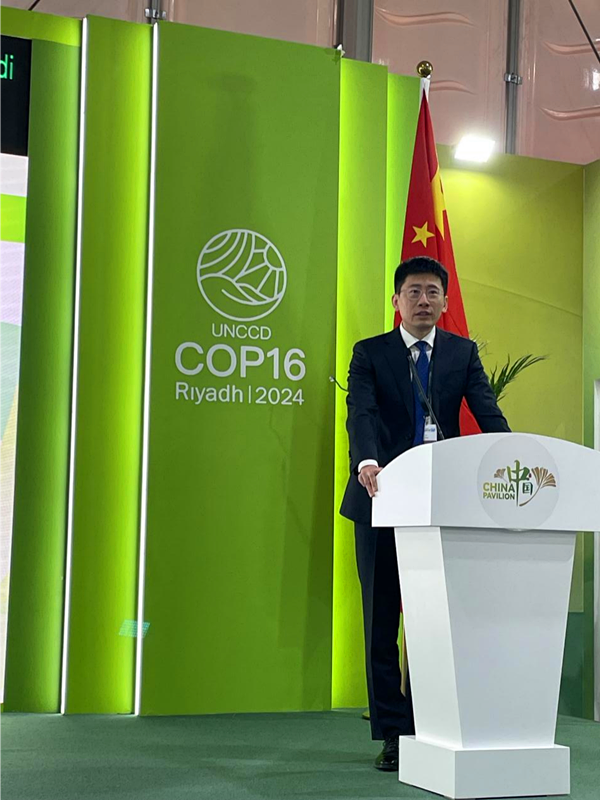[International Energy Network Live Report] On the morning of December 10th, the side event themed “Planning and Ecological Design of Solar PV Power Stations in Desert Areas” was held at the China Pavilion of the 16th session of the Conference of the Parties to the United Nations Convention to Combat Desertification in Riyadh. The conference will deeply discuss the latest research results, practical experience and innovative ideas on photovoltaic and land desertification control, promote the application of new energy in global land desertification control, and release photovoltaic power stations to promote desertification control development initiatives.
During the conference, Mr. Kan Cheng, Chief Bid Director of POWERCHINA Saudi Arabia, gave a report on “Practical Experience in Overseas Photovoltaic Project Construction”, showing the audience the main precautions, ecological protection, technological development and practical results in the construction of overseas photovoltaic projects.

Kan Cheng, Chief Bid Director of POWERCHINA Saudi Arabia, Middle East and North Africa Regional Headquarters of China Power Construction
According to Kan Cheng, as one of the earliest Chinese companies to go global, after more than 60 years of development, China Power Construction has become a leader in global clean and low-carbon energy, water resources and environmental construction, a backbone force in global infrastructure connectivity, and a leading enterprise serving the joint construction of the “Belt and Road”. In 2024, China Power Construction ranked 108th in the Fortune Global 500, ranked first in the ENR Global Top 150 Engineering Design Companies, ranked among the top 250 ENR Global Contractors and the top 250 International Contractors, and ranked first among Chinese companies in the Top 250 International Engineering Design Companies for 9 consecutive years.
In recent years, China Power Construction has seized the market opportunities of the global response to climate change and the goal of low-carbon energy transformation, and actively deployed overseas new energy industries. As of September 2024, PowerChina has signed wind power, photovoltaic, and solar thermal projects in more than 20 countries including Saudi Arabia, Vietnam, Pakistan, Thailand, Argentina, and Laos, with a total installed capacity of 58.75GW, including 20.35GW of wind power and 38.4GW of solar energy.
Kan Cheng said that PowerChina is committed to becoming a leader in the field of clean and low-carbon energy in the world, providing customers at home and abroad with integrated solutions for the entire industrial chain of new energy such as wind energy, solar energy, biomass, and ocean energy, with the mission of building clean energy, creating a green environment, and serving smart cities, and jointly promoting the sustainable development of mankind.
It is understood that there are large areas of desert Gobi in Saudi Arabia and even the entire Middle East and North Africa. The construction of photovoltaic power stations to utilize and improve the environmental protection environment is an important path for ecological governance. As one of the important photovoltaic power station construction units in the Middle East and North Africa, PowerChina has successively participated in the construction of many large-scale photovoltaic power stations. In Saudi Arabia, PowerChina has successively built three GW-level photovoltaic power station projects and accumulated rich experience in the construction of desert photovoltaic power stations.
“In terms of engineering design, the high resource assessment, array layout, wind and sand protection and electrical system design in desert areas are quite different from photovoltaic projects in other regions. It is necessary to carry out targeted design of photovoltaic power stations according to the characteristics of solar radiation intensity, sunshine time and ground reflection height in desert areas, so as to maximize the power generation capacity of photovoltaic modules and improve the economic benefits of power generation.
Secondly, due to the strong wind and sand in desert areas, it is necessary to consider sand prevention measures in the design. China Power Construction chooses to produce suitable tree species in desert areas, which can not only reduce wind speed and reduce the direct impact of wind and sand on photovoltaic power stations, but also improve the desert ecological environment to a certain extent.
In terms of engineering construction, the natural environment in desert areas is harsh, and construction workers face extreme weather conditions such as high temperature, drought, wind and sand. Labor protection measures, reasonable arrangement of working hours and health management are also crucial.” Kan Cheng said.
The geology of desert areas is complex and diverse, and various difficulties are often encountered during the early preparation and transportation process. In this regard, Kan Cheng gave his own suggestions: First, it is necessary to make adequate preparations during the geological survey and construction stages, which is one of the main risks affecting the construction and cost of desert photovoltaic projects; secondly, the transportation of large photovoltaic components, transformers, steel and other equipment and materials requires reasonable transportation tools and road conditions to ensure the smooth construction of the project.
Finally, Kan Cheng said that China Power Construction will continue to give full play to its advantages in the entire new energy industry chain, actively carry out international new energy industry cooperation, accelerate the development of green and low-carbon energy, and take new steps and show new achievements in the process of green and low-carbon energy development.






